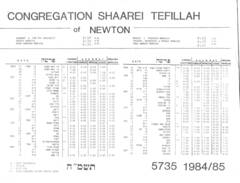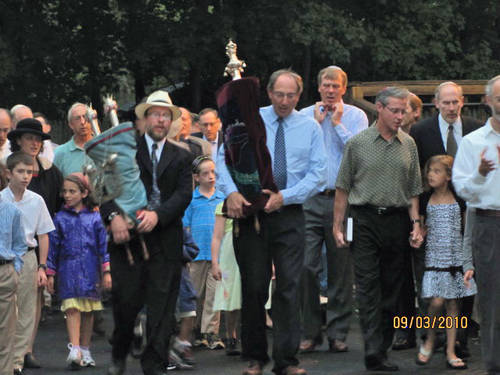History of Congregation Shaarei Tefillah
In the Beginning...
Congregation Shaarei Tefillah began on 14 Tishrei 5744 (Wednesday night, September 21, 1983), when several Newton families hastily organized an Orthodox minyan for Sukkot in one family's Newton Centre home. They intended this minyan to meet only through Shabbat Bereishit, nine days later. Word of this minyan spread rapidly through the Newton Jewish community. On the first night of the holiday, the family's sunroom was filled to capacity. The gathering swelled on subsequent days to over one hundred men and women, who overflowed into the backyard. Many came because they sensed an opportunity for greater spiritual intensity and more personal participation. The mood was electric. Addressed from a makeshift pulpit by such illustrious men as Professor Alexander Altmann z"l and Professor Marvin Fox z"l, participants responded with a fervor few had either expressed or experienced before. Although conceived as a temporary measure, the minyan took on a life of its own. After several hastily convened meetings, some two dozen families decided to continue to daven together and began taking steps to make this possible.
Shaarei Tefillah: A Shul on the Move
Each week for several months, the minyan moved from place to place. Members set up temporary sanctuaries in any home they could find with a living room large enough to accommodate rented folding chairs and a makeshift mechitza. Establishing a precedent of participation which continues to the present, volunteers undertook all congregational functions, whether religious or organizational. Members led services, read the Torah, and delivered divrei Torah on Shabbat morning. Several renowned rabbis from within the group agreed to act collectively as our founding board of Advisors, providing the fledgling congregation with halakhic direction. A five-person steering committee oversaw executive functions. In addition, members attended evening meetings in one another's homes, organized lectures, typed letters, stuffed envelopes, paid bills, and of course, cleaned living rooms and moved chairs, books, and Sifrei Torah. In December, the group, which by then numbered some 30 families, moved back into the home in which it first met. There they set up a more formal, though small, sanctuary in which they davened each Shabbat for the rest of that winter and the following spring. During that period, they also established a daily minyan which met for more than two years in the basement of another family's nearby home. As spring approached, growing membership and the renovation plans of our host family compelled the group to seek larger accommodations. After receiving the go-ahead from its Halakhic Committee, the minyan, which had collectively chosen the name Shaarei Tefilla, rented space in a gymnasium belonging to a local church on Furber Lane. The English transliteration of the name was later changed to "Shaarei Tefillah" at the urging of our beloved member and teacher, Professor Nahum Sarna z"l, a stickler for correct orthography.) "Furber Lane," where the minyan met each Shabbat for more than five years, felt like the congregation's first home.
back into the home in which it first met. There they set up a more formal, though small, sanctuary in which they davened each Shabbat for the rest of that winter and the following spring. During that period, they also established a daily minyan which met for more than two years in the basement of another family's nearby home. As spring approached, growing membership and the renovation plans of our host family compelled the group to seek larger accommodations. After receiving the go-ahead from its Halakhic Committee, the minyan, which had collectively chosen the name Shaarei Tefilla, rented space in a gymnasium belonging to a local church on Furber Lane. The English transliteration of the name was later changed to "Shaarei Tefillah" at the urging of our beloved member and teacher, Professor Nahum Sarna z"l, a stickler for correct orthography.) "Furber Lane," where the minyan met each Shabbat for more than five years, felt like the congregation's first home.
 back into the home in which it first met. There they set up a more formal, though small, sanctuary in which they davened each Shabbat for the rest of that winter and the following spring. During that period, they also established a daily minyan which met for more than two years in the basement of another family's nearby home. As spring approached, growing membership and the renovation plans of our host family compelled the group to seek larger accommodations. After receiving the go-ahead from its Halakhic Committee, the minyan, which had collectively chosen the name Shaarei Tefilla, rented space in a gymnasium belonging to a local church on Furber Lane. The English transliteration of the name was later changed to "Shaarei Tefillah" at the urging of our beloved member and teacher, Professor Nahum Sarna z"l, a stickler for correct orthography.) "Furber Lane," where the minyan met each Shabbat for more than five years, felt like the congregation's first home.
back into the home in which it first met. There they set up a more formal, though small, sanctuary in which they davened each Shabbat for the rest of that winter and the following spring. During that period, they also established a daily minyan which met for more than two years in the basement of another family's nearby home. As spring approached, growing membership and the renovation plans of our host family compelled the group to seek larger accommodations. After receiving the go-ahead from its Halakhic Committee, the minyan, which had collectively chosen the name Shaarei Tefilla, rented space in a gymnasium belonging to a local church on Furber Lane. The English transliteration of the name was later changed to "Shaarei Tefillah" at the urging of our beloved member and teacher, Professor Nahum Sarna z"l, a stickler for correct orthography.) "Furber Lane," where the minyan met each Shabbat for more than five years, felt like the congregation's first home.A Home to Call Our Own
In the meantime, a site-search committee located a home for sale on Commonwealth Avenue, in the heart of Newton Centre. The congregation purchased this property, but failed, after a costly and painful effort, to obtain the needed zoning relief required in order to use the house as a shul. This episode elicited much hostility and misunderstanding on the part of neighbors and Newton public officials. The congregation sold the property in 1985. About that time, however, Rabbi Mordecai Savitsky approached Shaarei Tefillah's leaders and offered to sell them his home at 35 Morseland Avenue, which had a synagogue in its basement. Once the sale was completed in July 1985, the congregation transferred to its new home all educational and religious activities other than its Shabbat and Yom Tov minyanim, which continued to be held in the larger quarters of the gym on Furber Lane.
It took more than four years and much expense for the congregation to design and build an addition onto the house on Morseland Avenue to serve as the main sanctuary and function room. With construction completed in early 1990, a dedication ceremony in March was marked by a joyous procession which carried the Sifrei Torah from the gymnasium to the new building.
Hiring a Rabbi... Maybe
During this period, members began discussing whether they wished to consider hiring a rabbi. The Halakhic Committee, which had served in lieu of a rabbi since the minyan's inception, expressed reluctance to continue in this capacity and encouraged the community to seek a rabbi. While many members wished to take this next step, others were reluctant. A primary reason expressed for this reluctance was fear of losing the congregation's active and participatory nature which so many members cherished. In addition, the still small (nearly one-hundred family congregation) felt unable to afford a full-time rabbi. After numerous meetings and open-forum discussions, it was decided to hire a part-time rabbi who would perform the functions of the Halakhic Committee, and provide spiritual guidance.
In 1991, Shaarei Tefillah hired Rabbi Moshe Simkovich to fill this role. As a member of the limudei kodesh faculty at Maimonides School, Rabbi Simkovich was familiar to many of the families and their high school-aged children. Rabbi Simkovich delivered divrei Torah, gave shiurim, and enriched in many other ways the religious lives of the Shaarei Tefillah community. When the congregation hired its first full-time rabbi, Rabbi Benjamin J. Samuels, in 1995, Rabbi Simkovich stayed in the community and remained an active member of the shul. In 2003, he and his family moved to Philadelphia, where he accepted a post as founding Principal of Stern High School. He has since served as the Rosh Yeshiva of Yeshivat Neginat Hatorah in Israel, and currently resides in Chicago.
Hiring a Full-Time Rabbi
In November 1993, Shaarei Tefillah celebrated its tenth anniversary using the occasion to reflect on its first decade and look forward to continued service to both the Orthodox community and to Klal Yisrael. In conjunction with its celebration, the shul undertook its first major fundraising effort. As the end of Rabbi Simkovich's term grew near, members again began discussing the possibility of hiring a full-time rabbi. The shul was experiencing continued growth, and in addition to the increasing numbers of B'nei and B'not Mitzvah and other life-cycle events of its members, there were scores of other communal events which a part-time rabbi could never hope to take part in. Shaarei Tefillah, as a Modern Orthodox congregation encouraging active member participation in leading services, giving shiurim (classes), and offering divrei Torah on Shabbat morning, stood out on the Boston Jewish landscape. The Congregation felt it had reached a point at which it needed leadership to provide halakhic guidance as well as represent the shul to the larger Jewish community. Rabbi Simkovich, unable to devote himself full-time to the rabbinate, urged the shul to begin an external search for a spiritual leader.
A rabbinic search committee was formed, and almost immediately centered its attention on a young rabbi who was then serving as assistant rabbi in New York City's The Jewish Center. Rabbi Benjamin J. Samuels came to Newton for an interview and met with overwhelming and enthusiastic support. He was hired as Shaarei Tefillah's first full-time rabbinic leader, and together with his wife Stephanie, and their first-born son Amitai, moved to Newton in September 1995.
 Expanding our Synagogue
Expanding our SynagogueIn 2009, we broke ground on an expansion of our synagogue building. In 2010, we starting using our beautiful new sanctuary while work continued on renovating the original building. In the spring of 2011, our new kiddush room and classrooms were completed, and are large enough to accommodate our growing community and its many activities.
Today
Currently, Shaarei Tefillah has a membership of approximately 250 families. With guidance from Rabbi Samuels, and with the continued dedication, leadership, and participation of its members, Shaarei Tefillah looks forward to advancing its mission of being a warm, welcoming and inclusive Torah community.
Additional Reading
Beit-Aharon, Rebecca. From the Archives (blog).
- "A History of Activism": How did Shaarei's early members advocate for a place to worship?
- "Still Worth Fighting For": What issues mattered to Shaarei Tefillah in Spring 1986? Are we still worth working for?
- "An All-Inclusive History": In the April 1999/Nisan 5759 Shaarei newsletter, a flyer advertises the May 2 event “Special Education in the Jewish Community: Valuing All Our Children,” a three-and-a-half hour conference presented by Etgar Noar, a then-new organization “dedicated to meeting the challenge of giving children with special needs a Jewish education.”
Rockoff, Avi. "On Their Shoulders: The Professors, the Beginnings, and Beyond." In Shaarei Torah: Commemorating 18 Years of Communal Divrei Torah, edited by Jennifer Mayer et al. Newton, MA: Congregation Shaarei Tefillah, 2003.
Fri, April 19 2024 11 Nisan 5784

